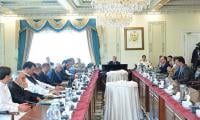China and the US – the two largest economies and trade partners in the world – are embroiled in an increasingly bitter trade war that could spiral out of control and trigger another crisis in the global economy.
The trade war started when US President Donald Trump imposed tariffs of 25 percent on Chinese imports worth $50 billion. China retaliated and imposed tariffs on some American imports. With time, this war intensified when the Trump administration imposed tariffs worth $200 billion on Chinese imports. The 10-percent tariff became effective on September 24 and might increase to 25 percent in January 2019 if both countries fail to strike a deal. Trump has further threatened to impose tariffs of worth $267 billion in 2019. This means that every product imported from China will be taxed in America.
The Chinese leadership has also suspended trade talks with the US to show its displeasure. It has accused the US of launching the “largest trade war in economic history”. Trade barriers can have serious consequences for the Chinese economy, which has continued to enjoy uninterrupted growth for three decades.
The intensified trade war between China and the US could also impact international relations as it will force big powers to look for alternative markets and negotiated trade deals. The battle to control, dominate and establish hegemony over different regions and countries will further intensify and trigger new conflicts, civil wars and increased tensions.
In his address to the UN General Assembly (UNGA), Trump has clarified his intentions regarding the trade ties with China and other countries. The following excerpts from his speech show what the world can expect from Trump: “America is governed by Americans. We reject the ideology of globalism, and we embrace the doctrine of patriotism...We believe that trade must be fair and reciprocal. The [US] will not be taken advantage of any longer. For decades, the US opened its economy – the largest, by far, on earth – with few conditions. We allowed foreign goods from all over the world to flow freely across our borders. Yet, other countries did not grant us fair and reciprocal access to their markets in return.
“Even worse, some countries abused their openness to dump their products, subsidise their goods, target our industries, and manipulate their currencies to gain unfair advantage over our country. As a result, our trade deficit ballooned to nearly $800 billion a year. For this reason, we are systematically renegotiating broken and bad trade deals.
“...The US lost over three million manufacturing jobs, nearly a quarter of all steel jobs, and 60,000 factories after China joined the WTO. And we have racked up $13 trillion in trade deficits over the last two decades. But those days are over. We will no longer tolerate such abuse”.
This speech offers a clear indication that the Trump administration has almost abandoned globalisation and wants to bring back protectionist policies and trade barriers. The present administration wants to stop the “unfair transfers of American technology and intellectual property to China” and protect jobs.
This war is not only being waged for trade purposes but also for the possession and hegemony over technology and innovations. The US fears that China will pose a serious threat to American domination and hegemony over technology, advanced scientific knowledge, and innovation. So, it is using trade tariffs to force China to accept the status quo and continue to produce what it is producing for the last three decades.
The other purpose of this trade war is to make imports into the US expensive to boost local manufacturing and produce cheaper products to revive America’s industrial sector. Another reason is to make the US attractive for foreign and local investment. The Trump administration has already reduced taxes for companies to make the US a competitive place. Japan, Europe and the US have remained the most attractive places for foreign investment for decades. But this started to change in the 1990s and in the beginning of the 21st century when China surpassed the US as the main recipient of foreign investment.
This foreign investment gives rise to manufacturing in China that, in turn, gives rise to exports. In 1980, China accounted for only 0.8 percent of the world exports of manufactured goods. By 2003, it accounted for 7.3 percent and now it accounts for 13 percent of world exports. America enjoyed a huge share in world trade when it was the global powerhouse of manufacturing and industrial products.
The Chinese economy benefited enormously from the export boom. It took full advantage of free trade and globalisation to develop its economy. European and American corporations and investors rushed to China to exploit its educated, well-disciplined and cheap labour force as Chinese workers were accustomed to working 80 hours a week for $80 per month as a salary.
Despite all his efforts and aggressive policies, Trump faces two main hurdles to reverse the globalisation process. First, globalisation has integrated the global economy with trade. Can he disintegrate and detach the seemingly well-integrated economy and trade without creating major disruptions and upheavals? Can the American economy absorb the shocks and disruptions caused by protectionist measures? While it is true that trade tariffs and other barriers will hurt the Chinese economy, there are still questions over whether the American economy can survive these tit-for-tat measures.
Second, since the dominance of neoliberalism and the free-market economy in the world, the role of finance capital has increased enormously. More and more profits have been channelled into financial speculation rather than productive investment. The deregulated financial markets have virtually become a single casino. How will Trump undo this global casino and channel this capital into production? How will Trump reverse this dominating trend in global capitalism?
The writer is a freelance journalist.
People stand in line up as election officials check their ballot papers during voting general election at a polling...
Women show their voter identity cards as they stand in a queue before casting their votes in Agartala. — PTIThe 18th...
Former prime minister Imran Khan. — Instagram/ imrankhan.ptiAn old saying has it that “when you dance with the...
Kashmiris in Indian illegally occupied Kashmir protesting against the Indian occupation as the forces of India looked...
A representational image showing residents walking at a wholesale market in Karachi. — AFP/FileOnce again there is...
A representational image showing late Pakistani human rights activist and Supreme Court lawyer Asma Jahangir. —...







